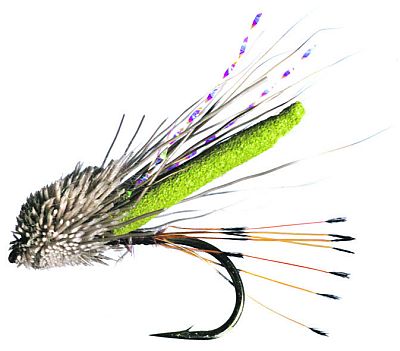 Jan’s Flies February 2010
Jan’s Flies February 2010
The week between Christmas and the New Year saw Bill and myself about as remote as one can get in Tasmania. We even visited some lakes we had not been to before. Yes, I am talking about the Western lakes.
In nearly forty years of wandering those areas we struck gold with the weather. I can not remember ever having six straight days of blue sky - the norm is two or three days. So having these superb days we covered as much water as possible. That country never gets any easier but at least one can polaroid when the blue sky is there. We found the fish in superb condition, not huge but in the one and a half to two kilogram mark, and plenty of them.
With the lovely weather we had a fair amount of wind which helps out as it puts a rough top on the water. It’s these conditions the better fish will cruise more frequently as they have the camouflage of a ruffled surface. The wind also helps to push the insects onto the water and so the cruising goes on. Never cast the fly AT these fish, present it to one side and a few feet in front and they will see it.
One of our days we had extreme wind so I put a grasshopper pattern on and fished blind amongst a rocky patch at the bottom end of a little lake. It was not hard with the heavy wind to slap the fly down on the water surface to try and get the attention of any fish feeding amongst the rocks. It took around four casts and a head came out ot grab that hopper. We ended up with a few fish from that area.
There are plenty of hoppers around now and the following pattern is a basic pattern that works well, but can be changed to suit the size and colour of what may be desired.
The Edward Hopper
Thread: Brown
Hook: Light guage size 8
Legs: Golden pheasant tippets
Body: Green, orange or brown foam cylinder
Wing: Two strips of sparkle
Head and wing: Deer hair
- Take thread two thirds the length of shank.
- Tie in a small bunch of golden pheasant tippets making sure an equal amount drop down each side of the hook shank giving that leggy look.
- Now with the thread move it forward so there is a nice space to form a head. Take the foam cylinder and tie it down with thread on the top of the shank. Make sure the body has some length off the bend of the hook. Cut this at an angle as is shown on the fly. Cut away any excess foam cylinder that may be left at the front.
- With a couple of strands of sparkle flash tie in over the back for the flash of a wing.
- With the dear hair cut a nice bunch and psin on enough for a head, make a few turns with thread at the eye of the hook, whip finish and varnish, cut thread away.
- With some sharp scissors or a razor blade form a nice head out of deer hair, do this a little at a time as one wrong cut and the shape will be lost.
Note: This fly has a wing, but most highland hoppers are wingless. The trout don’t care—it’s a good mouthful, and that’s all that matters to them.
If fishing this fly in extreme wind use a shortish leader as really long leaders are hard to handle in rough weather. Slap the fly down on the water and give it a couple of short pulls to give it life. I hope Edward gives you as much pleasure as it has me.




